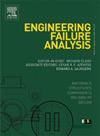铆接顺序对多铆接薄壁结构破坏影响的研究
IF 4.4
2区 工程技术
Q1 ENGINEERING, MECHANICAL
引用次数: 0
摘要
军用飞机铆接修复接头的力学性能研究仍然有限,特别是对多铆接结构的研究。研究了多铆钉连接的拉伸性能和破坏机理。结果表明:在拉伸加载过程中,应力和应变集中在中心轴附近,应变水平在49% ~ 55%之间发生屈曲;破坏顺序通常包括底部铆钉周围补丁的初始剪切破坏,随后是基础铝板断裂,随后是侧铆钉周围补丁的剪切破坏。铆接过程中引入的残余应力对拉伸性能影响较大;值得注意的是,通过改变断裂时间和载荷分布,分布模式比应力大小对裂缝的影响更为关键。在三种铆接序列中,扩散对称铆接结构具有最佳的拉伸性能,其最大拉伸载荷比星形对称结构高出约9.5%,同时也避免了基材与贴片之间的错位。本文章由计算机程序翻译,如有差异,请以英文原文为准。
Study on the influence of riveting sequence on the failure of Multi-Rivet Thin-Walled structures
Research on the mechanical performance of repaired riveted joints in military aircraft remains limited, particularly for multi-rivet configurations. This study investigates the tensile behavior and failure mechanisms of multi-rivet joints. Results indicate that stress and strain were concentrated near the central axis during tensile loading, with buckling occurring at strain levels between 49% and 55%. The failure sequence typically involves initial shear failure of the patch around the bottom rivet, followed by fracture of the base aluminum sheet, and subsequent shear failure of the patches surrounding the side rivets. Residual stresses introduced during the riveting process significantly affect tensile performance; notably, the distribution pattern exerts a more critical influence than stress magnitude by altering fracture timing and load distribution. Among the three riveting sequences analyzed, the diffusely symmetric riveting configuration demonstrates the best tensile performance, achieving a maximum tensile load approximately 9.5% higher than that of the star-symmetric arrangement, while also avoiding misalignment between the base material and the patch.
求助全文
通过发布文献求助,成功后即可免费获取论文全文。
去求助
来源期刊

Engineering Failure Analysis
工程技术-材料科学:表征与测试
CiteScore
7.70
自引率
20.00%
发文量
956
审稿时长
47 days
期刊介绍:
Engineering Failure Analysis publishes research papers describing the analysis of engineering failures and related studies.
Papers relating to the structure, properties and behaviour of engineering materials are encouraged, particularly those which also involve the detailed application of materials parameters to problems in engineering structures, components and design. In addition to the area of materials engineering, the interacting fields of mechanical, manufacturing, aeronautical, civil, chemical, corrosion and design engineering are considered relevant. Activity should be directed at analysing engineering failures and carrying out research to help reduce the incidences of failures and to extend the operating horizons of engineering materials.
Emphasis is placed on the mechanical properties of materials and their behaviour when influenced by structure, process and environment. Metallic, polymeric, ceramic and natural materials are all included and the application of these materials to real engineering situations should be emphasised. The use of a case-study based approach is also encouraged.
Engineering Failure Analysis provides essential reference material and critical feedback into the design process thereby contributing to the prevention of engineering failures in the future. All submissions will be subject to peer review from leading experts in the field.
 求助内容:
求助内容: 应助结果提醒方式:
应助结果提醒方式:


